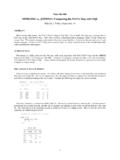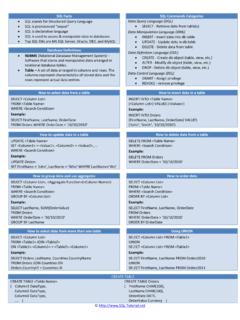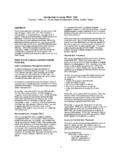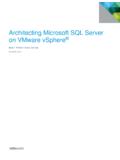Transcription of 268-29: Introduction to PROC SQL - SAS
1 1 Paper 268-29 Introduction to Proc SQLK atie Minten Ronk, Systems Seminar Consultants, Madison, WIABSTRACTPROC SQL is a powerful Base SAS Procedure that combines the functionality of DATA and PROC steps into a single SQL can sort, summarize, subset, join (merge), and concatenate datasets, create new variables, and print the resultsor create a new table or view all in one step!PROC SQL can be used to retrieve, update, and report on information from SAS data sets or other database products. Thispaper will concentrate on SQL s syntax and how to access information from existing SAS data sets. Some of the topicscovered in this brief Introduction include: Writing SQL code using various styles of the SELECT statement. Dynamically creating new variables on the SELECT statement. Using CASE/WHEN clauses for conditionally processing the data.
2 Joining data from two or more data sets (like a MERGE!). Concatenating query results LEARN PROC SQL?PROC SQL can not only retrieve information without having to learn SAS syntax, but it can often do this with fewer and shorterstatements than traditional SAS code. Additionally, SQL often uses fewer resources than conventional DATA and PROC steps. Further, the knowledge learned is transferable to other SQL EXAMPLE OF PROC SQL SYNTAXE very PROC SQL query must have at least one SELECT statement. The purpose of the SELECT statement is to name thecolumns that will appear on the report and the order in which they will appear (similar to a VAR statement on PROC PRINT).The FROM clause names the data set from which the information will be extracted from (similar to the SET statement).
3 Oneadvantage of SQL is that new variables can be dynamically created on the SELECT statement, which is a feature we do notnormally associate with a SAS Procedure:PROC SQL; SELECT STATE, SALES, (SALES * .05) AS TAX FROM USSALES;QUIT;(no output shown for this code)THE SELECT STATEMENT SYNTAXThe purpose of the SELECT statement is to describe how the report will look. It consists of the SELECT clause and severalsub-clauses. The sub-clauses name the input dataset, select rows meeting certain conditions (subsetting), group (oraggregate) the data, and order (or sort) the data:PROC SQL options; SELECT column(s) FROM table-name | view-name WHERE expression GROUP BY column(s) HAVING expression ORDER BY column(s);QUIT;A SIMPLE PROC SQLAn asterisk on the SELECT statement will select all columns from the data set.
4 By default a row will wrap when there is toomuch information to fit across the page. Column headings will be separated from the data with a line and no observationnumber will appear:PROC SQL; SUGI 29 Tutorials2 SELECT * FROM USSALES; QUIT;(see output #1 for results)A COMPLEX PROC SQLThe SELECT statement in it s simplest form, needs a SELECT and a FROM clause. The SELECT statement can also haveall six possible clauses represented in a query:proc sql; SELECT state, sum(sales) as TOTSALES FROM ussales WHERE state in ( WI , MI , IL ) GROUP BY state HAVING sum(sales) > 40000 ORDER BY state desc;quit;(see output #2 for results)These statements will be reviewed in detail later in the INFORMATION ON THE SELECTTo specify that only certain variables should appear on the report, the variables are listed and separated on the SELECT statement.
5 The SELECT statement does NOT limit the number of variables read. The NUMBER option will print a column onthe report labeled 'ROW' which contains the observation number:PROC SQL NUMBER; SELECT STATE, SALES FROM USSALES;QUIT;(see output #3 for results)CREATING NEW VARIABLESV ariables can be dynamically created in PROC SQL. Dynamically created variables can be given a variable name, label, orneither. If a dynamically created variable is not given a name or a label, it will appear on the report as a column with nocolumn heading. Any of the DATA step functions can be used in an expression to create a new variable except LAG, DIF, andSOUND. Notice the commas separating the columns:PROC SQL; SELECT SUBSTR(STORENO,1,3) LABEL= REGION , SALES, (SALES * .05) AS TAX, (SALES *.)
6 05) * .01 FROM USSALES;QUIT;(see output #4 for results)THE CALCULATED OPTION ON THE SELECTS tarting with Version , the CALCULATED component refers to a previously calculated variable so recalculation is notnecessary. The CALCULATED component must refer to a variable created within the same SELECT statement:PROC SQL; SELECT STATE, (SALES * .05) AS TAX, (SALES * .05) * .01 AS REBATE FROM USSALES;- or - SELECT STATE, (SALES * .05) AS TAX, CALCULATED TAX * .01 AS REBATE FROM USSALES; SUGI 29 Tutorials3 QUIT;(see output #5 for results)USING LABELS AND FORMATSSAS-defined or user-defined formats can be used to improve the appearance of the body of a report. LABELs give the abilityto define longer column headings:TITLE REPORT OF THE SALES ;FOOTNOTE PREPARED BY THE MARKETING DEPT.
7 ;PROC SQL; SELECT STATE, SALES FORMAT= LABEL= AMOUNT OF SALES , (SALES * .05) AS TAX FORMAT= LABEL= 5% TAX FROM USSALES;QUIT;(see output #6 for results)THE CASE EXPRESSION ON THE SELECTThe CASE Expression allows conditional processing within PROC SQL:PROC SQL; SELECT STATE, CASE WHEN SALES BETWEEN 0 AND 10000 THEN LOW WHEN SALES BETWEEN 10001 AND 15000 THEN AVG WHEN SALES BETWEEN 15001 AND 20000 THEN HIGH ELSE VERY HIGH END AS SALESCAT FROM USSALES;QUIT;(see results #7 for results)The END is required when using the CASE. Coding the WHEN in descending order of probability will improve efficiencybecause SAS will stop checking the CASE conditions as soon as it finds the first true value. Also note that the length ofSALESCAT will be the longest value (the length of VERY HIGH or nine characters).
8 No special length statement is requiredas it is in the data interesting thing about CASE-WHEN logic is that the same operators that are available on the WHERE statement, arealso available in CASE-WHEN logic. These operators are: All operators that IF uses (= , <, >, NOT, NE, AND, OR, IN, etc) BETWEEN AND CONTAINS or ? IS NULL or IS MISSING = * LIKEANOTHER CASEThe CASE statement has much of the same functionality as an IF statement. Here is yet another variation on the CASE expression:PROC SQL; SELECT STATE, CASE WHEN SALES > 20000 AND STORENO IN ( 33281 , 31983 ) THEN CHECKIT ELSE OKAY SUGI 29 Tutorials4 END AS SALESCAT FROM USSALES;QUIT;(see output #8 for results)ADDITIONAL SELECT STATEMENT CLAUSESThe GROUP BY clause can be used to summarize or aggregate data.
9 Summary functions (also referred to as aggregatefunctions) are used on the SELECT statement for each of the analysis variables:PROC SQL; SELECT STATE, SUM(SALES) AS TOTSALES FROM USSALES GROUP BY STATE;QUIT;(see output #9 for results)Other summary functions available are the AVG/MEAN, COUNT/FREQ/N, MAX, MIN, NMISS, STD, SUM, and capability Is similar to PROC SUMMARY with a CLASS occurs when a summary function is used without a GROUP BY. The result is a grand total shown on every line:PROC SQL; SELECT STATE, SUM(SALES) AS TOTSALES FROM USSALES;QUIT;(see output #10 for results)REMERGING FOR TOTALSS ometimes remerging is good, as in the case when the SELECT statement does not contain any other variables:PROC SQL; SELECT SUM(SALES) AS TOTSALES FROM USSALES;QUIT;(see output #11 for results)CALCULATING PERCENTAGER emerging can also be used to calculate percentages:PROC SQL; SELECT STATE, SALES, (SALES/SUM(SALES)) AS PCTSALES FORMAT= FROM USSALES;QUIT.
10 (see output #12 for results)Check your output carefully when the remerging note appears in your log to determine if the results are what you THE DATA IN PROC SQLThe ORDER BY clause will return the data in sorted order: Much like PROC SORT, if the data is already in sorted order,PROC SQL will print a message in the LOG stating the sorting utility was not used. When sorting on an existing column,PROC SQL and PROC SORT are nearly comparable in terms of efficiency. SQL may be more efficient when you need to sorton a dynamically created variable:PROC SQL; SELECT STATE, SALES FROM USSALES SUGI 29 Tutorials5 ORDER BY STATE, SALES DESC;QUIT;(see output #13 for results)SORT ON NEW COLUMNOn the ORDER BY or GROUP BY clauses, columns can be referred to by their name or by their position on the SELECT cause.















